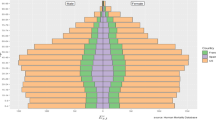Abstract
The future revision of capital requirements and a market-consistent valuation of non-hedgeable liabilities lead to an increasing attention on forecasting longevity trends. In this field, many methodologies focus on either modeling mortality or pricing mortality-linked securities (as longevity bonds). Following Lee–Carter method (proposed in 1992), actuarial literature has provided several extensions in order to consider different trends observed in European data set (e.g., the cohort effect). The purpose of the paper is to compare the features of main mortality models proposed over the years. Model selection became indeed a primary task with the aim to identify the “best” model. What is meant by best is controversial, but good selection techniques are usually based on a good balance between goodness of fit and simplicity. In this regard, different criteria, mainly based on residual and projected rates analysis, are here used. For the sake of comparison, main forecasting methods have been applied to deaths and exposures to risk of male Italian population. Weaknesses and strengths have been emphasized, by underlying how various models provide a different goodness of fit according to different data sets. At the same time, the quality and the variability of forecasted rates have been compared by evaluating the effect on annuity values. Results confirm that some models perform better than others, but no single model can be defined as the best method.
Similar content being viewed by others
References
Alho J.: Discussion of “The Lee–Carter method for forecasting mortality, with various extensions and applications”. North Am. Actuar. J. 4, 91–93 (2000)
Biffis E.: Affine processes for dynamic mortality and actuarial valuations. Insur. Math. Econ. 37, 443–468 (2005)
Blake D., Burrows W.: Survivor bonds: helping to hedge mortality risk. J. Risk Insur. 68, 339–348 (2001)
Blake D., Cairns A.J.G., Dowd K., Macminn R.: Longevity bonds: financial engineering, valuation and hedging. J. Risk Insur. 73, 647–672 (2006)
Brouhns N., Denuit M., Van Keilegom I.: Bootstrapping the Poisson log-bilinear model for mortality forecasting. Scand. Actuar. J. 3, 212–224 (2005)
Brouhns N., Denuit M., Vermunt J.: A Poisson log-bilinear regression approach to the construction of projected lifetables. Insur. Math. Econ. 31, 373–393 (2002)
Cairns A.J.G., Blake D., Dowd K.: A two-factor model for stochastic mortality with parameter uncertainty: theory and calibration. J. Risk Insur. 73, 687–718 (2006)
Cairns A.J.G., Blake D., Dowd K.: Pricing death: framework for the valuation and securization of mortality risk. Astin Bull. 36, 79–120 (2006)
Cairns, A.J.G., Blake, D., Dowd. K.: Modelling and management of mortality risk: a review. Pensions Institute Discussion Paper, PI-0814 (2008)
Cairns, A.J.G., Blake, D., Dowd, K., Coughlan, G.D., Epstein, D., Ong, A., Balevich, I.: A quantitative comparison of stochastic mortality models using data from England & Wales and the United States. 13(1):1–35 (2009)
Cramér H., Wold H.: Mortality variations in Sweden: a study in graduation and forecasting. Skandinavisk Aktuarietidskrift 18, 161–241 (1935)
Dahl M.: Stochastic mortality in life insurance: market reserves and mortality-linked insurance contracts. Insur. Math. Econ. 35, 113–136 (2004)
D’amato V., Haberman S., Russolillo M.: The Poisson log-bilinear Lee Carter model: efficient bootstrap in life annuity actuarial analysis. North Am. Actuar. J. 15(2), 315–333 (2011)
Dowd K., Cairns A.J.G., Blake D., Coughlan G.D., Epstein D., Khalaf-Allah M.: Backtesting stochastic mortality models: an ex-post evaluation of multiperiod-ahead density forecast. North Am. Actuar. J. 14(3), 281–298 (2010)
Dowd, K., Cairns, A.J.G., Blake, D., Coughlan, G.D., Epstein, D., Khalaf-Allah, M.: Evaluating the goodness of fit of stochastic mortality models. Pensions Institute Discussion Paper PI-0802 (2008)
Gerber U.H., Pafumi G.: Utility functions: from risk theory to finance. North Am. Actuar. J. 2, 74–100 (1998)
Haberman S., Renshaw A.: On age-period-cohort parametric mortality rate projections. Insur. Math. Econ. 45(2), 255–270 (2009)
Haberman S., Renshaw A.: A comparative study of parametric mortality projection models. Insur. Math. Econ. 48(1), 35–55 (2011)
Karlis D., Kostaki A.: Bootstrap techniques for mortality models. Biometrical J. 44(7), 850–866 (2001)
Lee R.D.: The Lee–Carter method for forecasting mortality, with various extensions and applications. North Am. Actuar. J. 4(1), 80–93 (2000)
Lee R.D., Carter L.R.: Modeling and forecasting U.S. mortality. J. Am. Stat. Assoc. 87, 659–675 (1992)
Lovasz E.: Analysis of Finnish and Swedish mortality data with stochastic mortality models. Eur. Actuar. J. 1, 259–289 (2011)
Milevsky M.A., Promislow S.D.: Mortality derivatives and the option to annuitise. Insur. Math. Econ. 29, 299–318 (2001)
Pitacco, E.: From Halley to “frailty”: a review of survival models for actuarial calculations. Giornale dell’ Istituto Italiano degli attuari, LXVII(1–2):17–47 (2004)
Plat R.: On stochastic mortality modeling. Insur. Math. Econ. 45(3), 393–404 (2009)
Renshaw A.E., Haberman S.A.: Cohort based extension to the Lee–Carter model for mortality reduction factors. Insur. Math. Econ. 38, 556–570 (2006)
Willets R.C.: The Cohort effect: insights and explanations. Br. Actuar. J. 10(4), 833–877 (2004)
Wills, S., Sherris, M.: Integrating financial and demographic longevity risk models: an Australian model for financial applications. Australian School of Business Research Paper, ACTL05 (2008)
Author information
Authors and Affiliations
Corresponding author
Rights and permissions
About this article
Cite this article
Biffi, P., Clemente, G.P. Selecting stochastic mortality models for the Italian population. Decisions Econ Finan 37, 255–286 (2014). https://doi.org/10.1007/s10203-012-0131-9
Received:
Accepted:
Published:
Issue Date:
DOI: https://doi.org/10.1007/s10203-012-0131-9
JEL Classification
- C02 - Mathematical methods
- C52 - Model evaluation, validation and selection
- G22 - Insurance; Insurance companies




